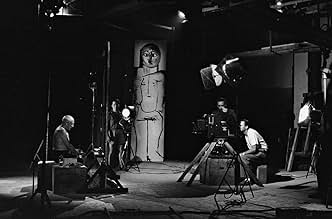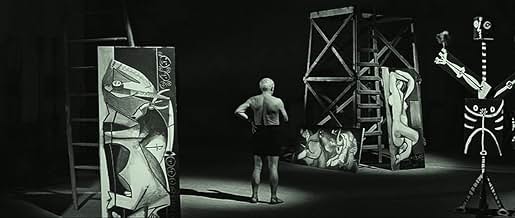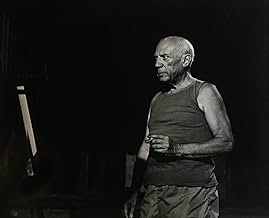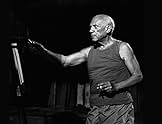VALUTAZIONE IMDb
7,6/10
2823
LA TUA VALUTAZIONE
Aggiungi una trama nella tua linguaA filmed record of Pablo Picasso painting numerous canvases for the camera, allowing us to see his creative process at work.A filmed record of Pablo Picasso painting numerous canvases for the camera, allowing us to see his creative process at work.A filmed record of Pablo Picasso painting numerous canvases for the camera, allowing us to see his creative process at work.
- Premi
- 1 vittoria e 1 candidatura in totale
Pablo Picasso
- Self
- (as Picasso)
Henri-Georges Clouzot
- Self
- (non citato nei titoli originali)
Claude Renoir
- Self
- (non citato nei titoli originali)
Recensioni in evidenza
If there was one word to describe this film for me, it would be "inspirational". And I think anyone who practices art or appreciates the process of art, can find this film enjoyable to watch. The film's title speaks for itself. We are engaged in an experimental documentary watching a prodigy at work and trying to unravel the magic of how it all happens. In the beginning there is a voice-over narrated introduction to the film, "Nobody knew what Rimbaud thought of when he wrote the poem "the drunk boat"." And then we realize that we are in for a real treat. Who would ever guess that the master of cubism would allow us to see his creative ideas at work? Most artists are very stubborn about this sort of thing, but then again most famous artists are also pretty ego-centric. The film places the camera behind a canvas that leaves the image transparent so that we can see the painting process without looking over the shoulder. There is a beautiful classical score along with this film and as the drawings progress, Picasso then takes on bigger challenges with paintings. The pacing is just right where the drawing process starts slow and then the strokes become faster with time-lapse photography. There is an amazing moment where the cameraman warns Picasso that he is about to run out of film. Picasso asks how many feet is left and calculates the timing of his painting and just at the last second, Picasso transforms the entire piece into something unexpected and radically different. We can see the spontaneity and playfulness in his work. The end is a mural shaped painting that evolves through many stages until Picasso says something like "its ruined. I have ruined the painting and yet at the same time, its improving." This is an indication of Picasso's fearless drive. When he paints, he is on fire. He works diligently for hours. Its fascinating to see little figures that he will paint over and over with more detail or more color. He wants to emphasize details that seem so ambiguous and its as if he's saying to the audience "look at this" "keep looking at this" "this is important." I first saw this film in the theater when I was about ten or twelve years old. I'm glad my family friends took me to see this. It has inspired me throughout the years. I saw the film again when I was twenty-four and it was just as I remembered it. After it was over, I did the same thing I did when I first saw the film; I pulled out a sketchbook and started drawing. This film is a real treat.
I received a VHS copy of this film from a friend who was going to trash it. My mother weaned me on trips to art galleries, spoon fed me stories of the personal lives of classic and modern masters, I worked in an art gallery liaisoning with the artists we represented and studied the psychology of creativity in college. This film had me riveted! I felt as though I was invited to eavesdrop, peek in on a great master at work. Every brush stroke was fascinating. I enjoyed the trip Picasso took me on as he started out painting one image and changed it into something else along the way. I enjoyed watching what appeared to be random brush strokes turn into a completed thought. This film helped me feel what it must be like to know when to stop... to know when you have finished a work... when you may have overworked it, when you may not have quite completed. It made me want to paint, not for others but for the simple pleasure one gets from the act of putting pigment on paper. It allowed me to feel free to create without fear of criticism. A must see for all artist and art lovers.
A-one-of-a-kind look at the artistic process, the unique art documentary captures the creativity itself. Two friends, the great painter and the great director, Pablo Picasso and Henri-George Clouzot decided to do what Goethe's Faust had dreamed about - to capture and to store forever the moment of beauty and inspiration. Picasso conceives, sketches, and paints twenty canvases before our eyes as the camera rolls. The film did not solve the mystery of Picasso who had said about himself, "When I was 9 years old, I could paint like Rafael; as an adult, all my life I tried to learn how to paint like a child" but it lets us to be the eye-witnesses of the amazing process - the birth of twenty works of art into existence. Twenty exiting moments the only Artist could live through are captured forever for us to enjoy again and again. Clouzot uses a specially designed transparent 'canvas' to provide an unobstructed view and different techniques including slow motion animation to let the main character, the invisible Picasso's brush speak for itself. The film is accompanied by exquisite music and gorgeous photography by Claude Renoir, grandson of impressionist painter Pierre-Auguste Renoir and nephew of Jean Renoir. The paintings created by Picasso in the film cannot be seen anywhere else. They were destroyed upon completion of the film. The French government has taken over the preservation of the original negative and has declared this truly unique and priceless documentary a national (and I would call it an international) treasure.
Criterion DVD also includes "Guernica", a short documentary directed in 1950 by Alain Resnais before any of his feature films. Picasso's "Guernica" is one of the most famous paintings of the 20th Century which was created by the artist in response to bombing and destroying the ancient Basque town of Guernica by German aviation on April 27 1937 during Spanish Civil War. The painting is a passionate protest against war as well as the fascinating work of art. Resnais' 13 minutes short film is based on paintings, drawings, and sculptures by Pablo Picasso from 1902 until 949 including "Guernica" and is set against the ode written by French lyrical poet Paul Éluard and recited by Jacques Pruvost and María Casarès. In his early short film, Resnais already uses his famous jump cuts and cross-fades. "Guernica" is a valuable feature which goes well together with the marvelous "The Mystery of Picasso" and adds to understanding one of the most prolific and mysterious Artists of the last century.
Criterion DVD also includes "Guernica", a short documentary directed in 1950 by Alain Resnais before any of his feature films. Picasso's "Guernica" is one of the most famous paintings of the 20th Century which was created by the artist in response to bombing and destroying the ancient Basque town of Guernica by German aviation on April 27 1937 during Spanish Civil War. The painting is a passionate protest against war as well as the fascinating work of art. Resnais' 13 minutes short film is based on paintings, drawings, and sculptures by Pablo Picasso from 1902 until 949 including "Guernica" and is set against the ode written by French lyrical poet Paul Éluard and recited by Jacques Pruvost and María Casarès. In his early short film, Resnais already uses his famous jump cuts and cross-fades. "Guernica" is a valuable feature which goes well together with the marvelous "The Mystery of Picasso" and adds to understanding one of the most prolific and mysterious Artists of the last century.
Director Henri-Georges Clouzot, best known in America for his expert thrillers (Diabolique, The Wages of Fear, Le Corbeau) captures a different kind of suspense in this astonishing documentary: can the viewer think faster than Picasso?
Of course not, don't be ridiculous. Pablo Picasso, seen here in his seventies, creates 20-odd paintings for the camera (a couple of them in real time), running rings around us as he goes. We see a line cross the screen, and then another, and then color spatters about; drawn on bleed-through paper the images come to us unmediated, like daydreams. Before we know it scenes take shape, populated by Picasso's stock company of matadors, clowns, leering old men, and towering, serene, bare-breasted women, their faces regally aloof.
This is Picasso Playful. Clouzot informs him at one point that there are only five minutes of film left and asks him what he wants to do. The old man replies "It'll be a surprise," quickly sketching a bouquet of roses and then taking it through acrobatic transformations, faking us out with deadpan glee. His buoyancy counterweights some of the director's more awkward touches, such as the portentous intro, some over-dramatic music, a few probably staged conversations... but who cares? This is dynamic, visual cinema-- in a sense, a great animated film.
Some of the earlier drawings are merely a master's doodles; others make your jaw drop with their absolute sureness of line. He'll send a stroke wriggling upward, graceful as a ribbon of smoke, and suddenly that wriggle is a bull with man tossed on its horns, and as the shapes gather and the colors erupt the thing becomes impossibly beautiful, a small perfection. Picasso returns to the image later, breaking out the oils, and here the film truly takes off. "I want to go deeper," Picasso tells Clouzot, and he does. We realize what we were missing in those first drawings: texture. The head of a goat coheres and takes on animal reality, the pigments bright as stained glass. Picasso ages it, makes it solid. What would be a major work for a lesser artist here is a throwaway, literally; the paintings were destroyed after filming. The least of them could have paid for my house.
In that intro Clouzot says something about "looking into the mind of the artist" or somesuch, but the title really says it all. At the beginning the artist saunters out shirtless from the studio's shadows. At the end he declares, "It is finished," and saunters back. What could possibly account for the existence of a Pablo Picasso remains a mystery untouched.
Of course not, don't be ridiculous. Pablo Picasso, seen here in his seventies, creates 20-odd paintings for the camera (a couple of them in real time), running rings around us as he goes. We see a line cross the screen, and then another, and then color spatters about; drawn on bleed-through paper the images come to us unmediated, like daydreams. Before we know it scenes take shape, populated by Picasso's stock company of matadors, clowns, leering old men, and towering, serene, bare-breasted women, their faces regally aloof.
This is Picasso Playful. Clouzot informs him at one point that there are only five minutes of film left and asks him what he wants to do. The old man replies "It'll be a surprise," quickly sketching a bouquet of roses and then taking it through acrobatic transformations, faking us out with deadpan glee. His buoyancy counterweights some of the director's more awkward touches, such as the portentous intro, some over-dramatic music, a few probably staged conversations... but who cares? This is dynamic, visual cinema-- in a sense, a great animated film.
Some of the earlier drawings are merely a master's doodles; others make your jaw drop with their absolute sureness of line. He'll send a stroke wriggling upward, graceful as a ribbon of smoke, and suddenly that wriggle is a bull with man tossed on its horns, and as the shapes gather and the colors erupt the thing becomes impossibly beautiful, a small perfection. Picasso returns to the image later, breaking out the oils, and here the film truly takes off. "I want to go deeper," Picasso tells Clouzot, and he does. We realize what we were missing in those first drawings: texture. The head of a goat coheres and takes on animal reality, the pigments bright as stained glass. Picasso ages it, makes it solid. What would be a major work for a lesser artist here is a throwaway, literally; the paintings were destroyed after filming. The least of them could have paid for my house.
In that intro Clouzot says something about "looking into the mind of the artist" or somesuch, but the title really says it all. At the beginning the artist saunters out shirtless from the studio's shadows. At the end he declares, "It is finished," and saunters back. What could possibly account for the existence of a Pablo Picasso remains a mystery untouched.
One of the greatest filmmakers of France, Henri-Georges Clouzot, makes a film about his friend Pablo Picasso, perhaps the 20th Century's most renown artist. Clouzot begins with a proposition: if one were present at the conception of a great artistic masterpiece such as Mozart's Jupiter Symphony, and could peek inside the mind of the artist, what would one see? Fortunately, the visual art of painting offers a filmmaker that insight, and so Clouzot begins with Picasso in a dark room with white light directed at an empty canvas. The artist, like a bullfighter, confronts and ultimately displaces the empty space with drama and suspense. Clouzot takes a minimalist approach which chooses to focus on the art rather than the artist, and he achieves this objective by having Picasso sit on one side of a translucent canvas, and the camera on the other capturing only the ink or paint that has been administered, without the distraction or impediment of the artist - pure creation. A window into the mind of the artist! Twenty artworks are created in this manner, each being overlayed with the often suspenseful sounds of Georges Auric's excellent score. With THE MYSTERY OF PICASSO, art becomes exhilarating as one attempts to anticipate what Picasso will do next. "How will he resolve this problem?" Clouzot has created a priceless document for anyone seriously interested in art.
Lo sapevi?
- QuizSpecial transparent 'canvases' were constructed so that Pablo Picasso could paint on one side and 'Renoir, Claude' and Henri-Georges Clouzot could film the other.
- Citazioni
Pablo Picasso: I do not look for, I find!
- ConnessioniFeatured in Picasso (1985)
I più visti
Accedi per valutare e creare un elenco di titoli salvati per ottenere consigli personalizzati
- How long is The Mystery of Picasso?Powered by Alexa
Dettagli
- Data di uscita
- Paese di origine
- Lingua
- Celebre anche come
- The Mystery of Picasso
- Azienda produttrice
- Vedi altri crediti dell’azienda su IMDbPro
Botteghino
- Lordo Stati Uniti e Canada
- 267.836 USD
- Fine settimana di apertura Stati Uniti e Canada
- 19.143 USD
- 23 feb 1986
- Tempo di esecuzione1 ora 18 minuti
- Colore
Contribuisci a questa pagina
Suggerisci una modifica o aggiungi i contenuti mancanti

Divario superiore
By what name was Il mistero Picasso (1956) officially released in India in English?
Rispondi




















